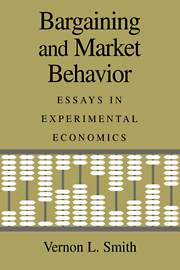18 - Stock Market Bubbles in the Laboratory
Published online by Cambridge University Press: 29 October 2009
Summary
Rational expectations models predict that if individuals have common expectations (or priors) as to the value of an asset, and this common value is equal to the dividend value of the asset, then trades, if they occur, will be at prices near intrinsic dividend value (Tirole, 1982). Contrary to this, consider the data in Figure 18.1 which lists the average weekly share price and corresponding net asset value (NAV) for the Spain Fund. The price of the Spain Fund shares from July 1989 to August 1990 begins at a discount from NAV, rises to a premium of 250% over NAV by week 15, and ultimately “crashes” back to a discount by week 61.There is much controversy over the behavior of closed end funds, which still remains a puzzle for a rational expectations theory of asset pricing (see Lee et al., 1991).
Explanations of deviations from NAV rely on models that focus on distinct investor types and their expectations. Instead of entering the debate concerning the interpretation of the price behavior of closed end funds, we shall rely on laboratory methods in economics that allow us to investigate propositions on price formation in a controlled fundamental value environment. In the economy, control over fundamental value and investor information is rarely possible; therefore, minimal conditions for studying the role of expectations in stock market valuations cannot be identified. Smith et al. (1988; hereafter SSW) report the results of laboratory asset markets in which each trader receives an initial portfolio of cash and shares of a security with a dividend horizon of 15 trading periods. Before the tth trading period, the expected dividend value of a share [e.g., $0.24(15 − t + 1)]…
- Type
- Chapter
- Information
- Bargaining and Market BehaviorEssays in Experimental Economics, pp. 414 - 433Publisher: Cambridge University PressPrint publication year: 2000
- 1
- Cited by



